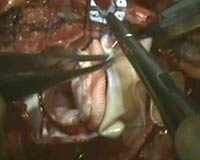ALERT!
This site is not optimized for Internet Explorer 8 (or older).
Please upgrade to a newer version of Internet Explorer or use an alternate browser such as Chrome or Firefox.
Adult Congenital Pulmonary Valve Replacement: A Simple, Effective, and Reproducible Technique
Presented at the STSA 2010 Annual Meeting

Pulmonary valve replacement is a relatively uncommon operation in adults, with the exception of those patients operated on previously for congenital heart disease. In children with lesions involving pulmonary stenosis, the pulmonary valve is often excised and the right ventricular outflow tract is augmented with a transannular outflow tract patch. Prosthetic valves are rarely used in infants and small children undergoing Tetralogy of Fallot repair due to size constraints. Right ventricular dilation and dysfunction often develops in adulthood as a result of the the pulmonary insufficiency created by these operations. Subsequent placement of a competent pulmonary valve is a means to eliminate the volume overload and prevent further deterioration.
Without the valve size constraints present at prior to operations, these patients are well served by the placement of adult-sized bioprosthetic valves. There are limited descriptions in the adult cardiac literature of the actual technique of pulmonary valve replacement. This video demonstrates our current technique and the pitfalls encountered when performing bioprosthetic pulmonary valve replacement in adults.
♣
Figures in the video first appeared in the article "Adult Congenital Pulmonary Valve Replacement: A Simple, Effective, and Reproducible Technique" (Congenital Heart Disease, 2: 314–318. doi: 10.1111/j.1747-0803.2007.00118.x) and are displayed with the permission of John Wiley and Sons who hold the copyright.





Comments